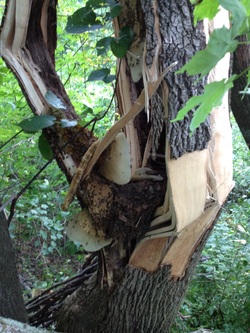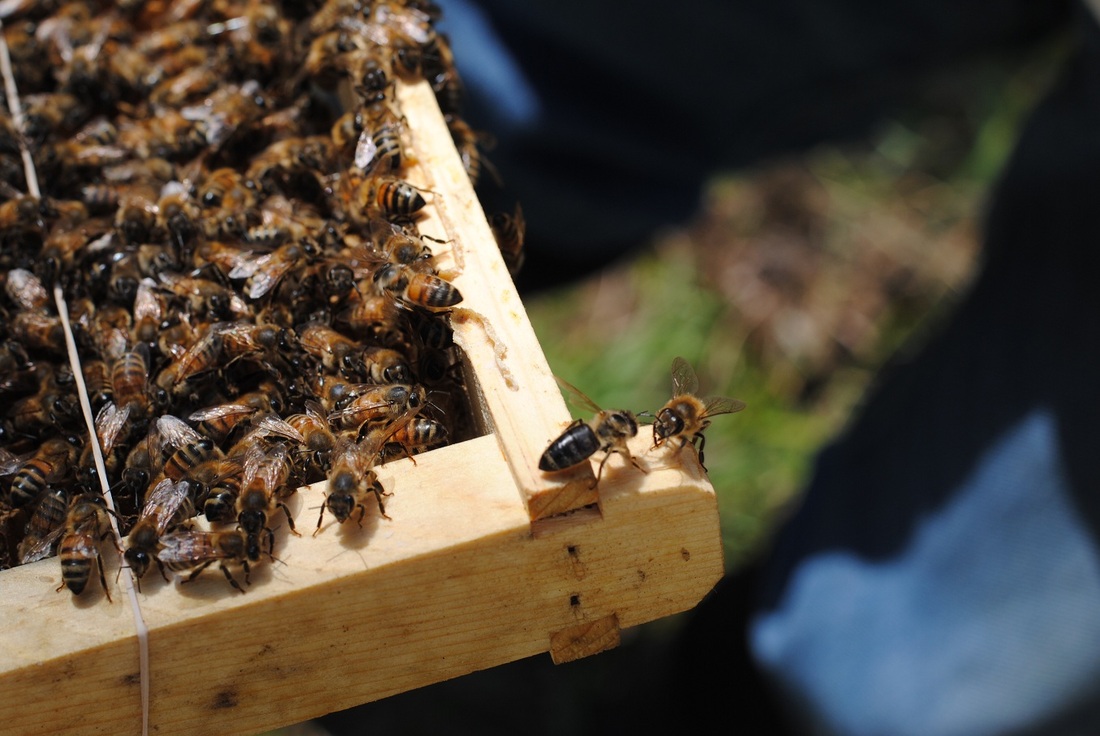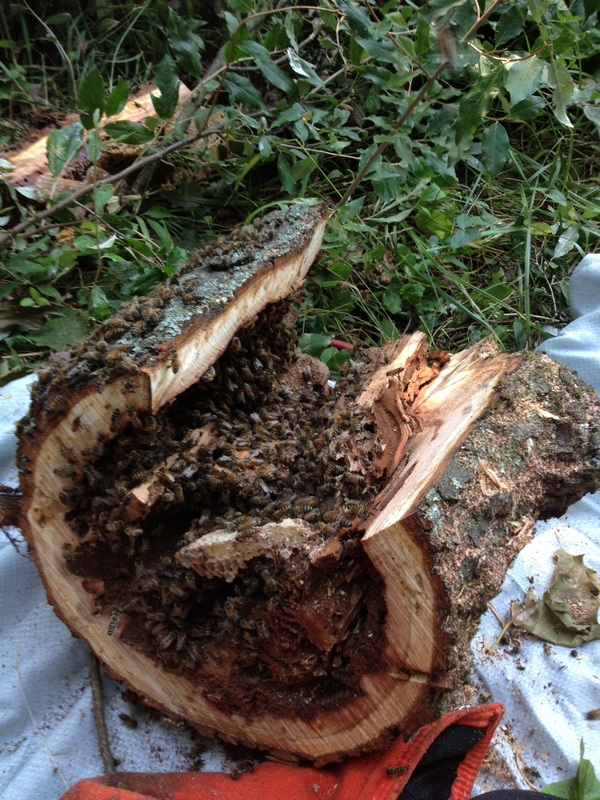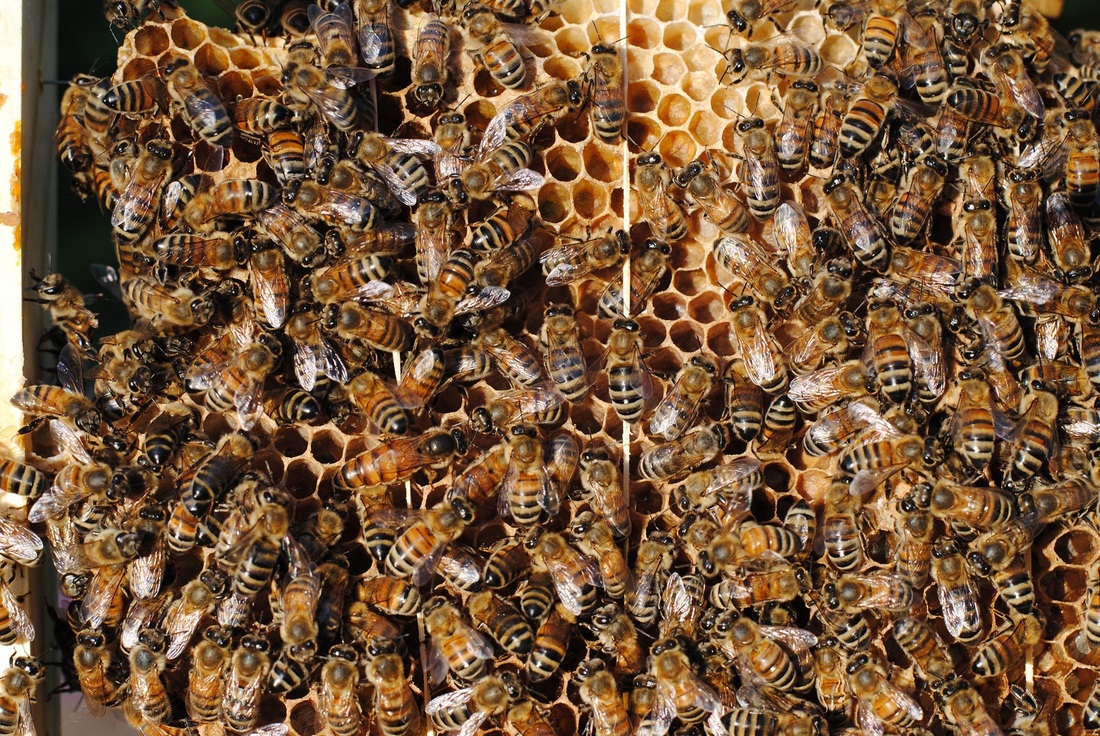
While our July 4th staycation was not quite Hugh Grant worthy, it was quite dramatic by our standards. The prior Friday our area experienced a derecho storm that knocked out our electricity along with millions of others in Indiana, Ohio, West Virginia, Maryland and Virginia. Just when our power was restored we were hit with another hard hail storm on Sunday that had us bringing out the candles. Our staycation appeared destined to take a rustic theme.
As rough as we had it during a few days of pioneer style life with temps in excess of one hundred degrees, the storms brought devastation to many of the feral bee colonies in our area. A fellow hobby farmer contacted us on Monday to investigate some damaged bee trees on her farm. She didn't know that she had any feral bee colonies, but when assessing her storm damage she discovered that she had three bee trees that had fallen on her fences and trails. On quick inspection two of the trees were nearly destroyed. What wasn't destroyed by the trauma of collapse was finished off by the sweltering heat and open exposure. The third colony had fared much better having fallen with the cavity mostly undamaged.
We celebrated Independence Day by liberating the farm's surviving bees from their destroyed home. For the two most heavily damaged trees, there wasn't much to salvage. We cut out the viable comb and brood and attempted to trap a few hundred bees still in the ruptured cavity. The third tree represented our first attempt at a realistic rescue. Our initial plan was to cut the log above and below the cavity, transport the log in tact to our bee yard, and deal with a trapout or cutout at our convenience. Unfortunately a quick check with a drill proved that most of the tree, at least a 12 foot section, was hollow or rotten and my first cut clipped the bottom of the combs. This was proving to be a bit more complicated than hoped and we moved into a full scale cutout. We attempted to remove as much comb from the cavity as we could reach, cut that section of the tree, and dumped the bees onto a light colored sheet in front of our transport box. We worked our way up the cavity a section at a time. We were very fortunate to spot the queen on the sheet during one of the dumps. We quickly scooped her up and deposited her in the box on the cutout comb. With brood comb and the queen inside the box, the bees became much more cooperative moving into the capture box. After a few hours we had salvaged most of the comb. The capture box was left at the entrance site of the fallen log overnight. Early the next morning we stapled hardware cloth over the entrance and headed home with rescued feral bee colony in tow.
That would have been enough excitement for any week, but we're talking about a staycation here. On Friday one of the elder statesmen of the beekeeper's association phoned us. He has been doing swarm removals, cutouts and trapouts in our county longer than I have been alive. At our last association meeting we had discussed some feral colonies in our area and he was happy to find others in the club that were interested in swarms and feral colony collections. He had been contacted about a swarm at a nearby high school and a fallen bee tree at the city country club. The excessive temperatures proved too much for him so he provided us with the contact information for both if we were interested.
The swarm collection was straightforward enough. A small secondary swarm had set up on the side of a brick wall near a downspout about 18 inches off the ground. My first attempt at this collection didn't take and upon return the bees had resettled on the wall. I added a frame of drawn comb with eggs to entice them to settle in the swarm box. The frame of comb and eggs did the trick and on Sunday morning we had added our second colony of the week. Turns out the swarm queen was lost before or during the collection and we ended up with a frame of queen cells, but that's a topic for a future update.
Our attempt to rescue the bees from the country club bee tree was less fruitful. We had to wait for the operations team to prep the site. By the time we were able to execute the cutout, most of the bees had absconded and the brood has started to decay. We were able to remove the comb from the tree and clear away the few hundred remaining bees at the site.
We hadn't planned to spend our staycation with two power outages, the warmest temperatures in over six decades, cutting out four bee trees and collecting a swarm, but it certainly made for a memorable holiday. We now have five colonies in our apiary; one from a swarm trap, two from swarm collections, one from a house cutout and one from a bee tree cutout.
Multiple mite infestations and Colony Collapse Disorder have dramatically reduced the feral bee population in our country, wiping out much of the bees' genetic diversity. Maintaining active feral colonies and rescuing those in jeopardy is critical to sustain what little diversity is left from the honey bee's four centuries on our continent. We're thrilled that we had the chance to rescue the colonies we could. If you know of a feral bee colony, please take the time to register their location with the Feral Bee Project at http://www.savethehives.com/fbp/Home.html. If you have a fallen bee tree or colony that needs removal, contact your local beekeeper's association to locate a beekeeper or removal specialist.
As rough as we had it during a few days of pioneer style life with temps in excess of one hundred degrees, the storms brought devastation to many of the feral bee colonies in our area. A fellow hobby farmer contacted us on Monday to investigate some damaged bee trees on her farm. She didn't know that she had any feral bee colonies, but when assessing her storm damage she discovered that she had three bee trees that had fallen on her fences and trails. On quick inspection two of the trees were nearly destroyed. What wasn't destroyed by the trauma of collapse was finished off by the sweltering heat and open exposure. The third colony had fared much better having fallen with the cavity mostly undamaged.
We celebrated Independence Day by liberating the farm's surviving bees from their destroyed home. For the two most heavily damaged trees, there wasn't much to salvage. We cut out the viable comb and brood and attempted to trap a few hundred bees still in the ruptured cavity. The third tree represented our first attempt at a realistic rescue. Our initial plan was to cut the log above and below the cavity, transport the log in tact to our bee yard, and deal with a trapout or cutout at our convenience. Unfortunately a quick check with a drill proved that most of the tree, at least a 12 foot section, was hollow or rotten and my first cut clipped the bottom of the combs. This was proving to be a bit more complicated than hoped and we moved into a full scale cutout. We attempted to remove as much comb from the cavity as we could reach, cut that section of the tree, and dumped the bees onto a light colored sheet in front of our transport box. We worked our way up the cavity a section at a time. We were very fortunate to spot the queen on the sheet during one of the dumps. We quickly scooped her up and deposited her in the box on the cutout comb. With brood comb and the queen inside the box, the bees became much more cooperative moving into the capture box. After a few hours we had salvaged most of the comb. The capture box was left at the entrance site of the fallen log overnight. Early the next morning we stapled hardware cloth over the entrance and headed home with rescued feral bee colony in tow.
That would have been enough excitement for any week, but we're talking about a staycation here. On Friday one of the elder statesmen of the beekeeper's association phoned us. He has been doing swarm removals, cutouts and trapouts in our county longer than I have been alive. At our last association meeting we had discussed some feral colonies in our area and he was happy to find others in the club that were interested in swarms and feral colony collections. He had been contacted about a swarm at a nearby high school and a fallen bee tree at the city country club. The excessive temperatures proved too much for him so he provided us with the contact information for both if we were interested.
The swarm collection was straightforward enough. A small secondary swarm had set up on the side of a brick wall near a downspout about 18 inches off the ground. My first attempt at this collection didn't take and upon return the bees had resettled on the wall. I added a frame of drawn comb with eggs to entice them to settle in the swarm box. The frame of comb and eggs did the trick and on Sunday morning we had added our second colony of the week. Turns out the swarm queen was lost before or during the collection and we ended up with a frame of queen cells, but that's a topic for a future update.
Our attempt to rescue the bees from the country club bee tree was less fruitful. We had to wait for the operations team to prep the site. By the time we were able to execute the cutout, most of the bees had absconded and the brood has started to decay. We were able to remove the comb from the tree and clear away the few hundred remaining bees at the site.
We hadn't planned to spend our staycation with two power outages, the warmest temperatures in over six decades, cutting out four bee trees and collecting a swarm, but it certainly made for a memorable holiday. We now have five colonies in our apiary; one from a swarm trap, two from swarm collections, one from a house cutout and one from a bee tree cutout.
Multiple mite infestations and Colony Collapse Disorder have dramatically reduced the feral bee population in our country, wiping out much of the bees' genetic diversity. Maintaining active feral colonies and rescuing those in jeopardy is critical to sustain what little diversity is left from the honey bee's four centuries on our continent. We're thrilled that we had the chance to rescue the colonies we could. If you know of a feral bee colony, please take the time to register their location with the Feral Bee Project at http://www.savethehives.com/fbp/Home.html. If you have a fallen bee tree or colony that needs removal, contact your local beekeeper's association to locate a beekeeper or removal specialist.




 RSS Feed
RSS Feed